
 Heavy Cruisers of the IJN (1924-27): Aoba, Kinugasa
Heavy Cruisers of the IJN (1924-27): Aoba, KinugasaWW2 IJN Cruisers:
Furutaka class | Aoba class | Nachi class | Takao class | Mogami class | Tone classTenryu class | Kuma class | Nagara class | Sendai class | Katori class | Agano class | Oyodo
Tsushima | Asama | Tokiwa | Yakumo | Izumo | Kasuga | Hirado
The two Aoba class thus followed the Furutaka a year apart as heavy cruisers, and their development did not took into account the serious issues of the two previous ships. They had from the start three twin turrets for their main armament. On the other hand, their torpedo tubes were still unusually placed in six fixed tubes on the broadside. A first modification in 1932 consisted in adding eight Type 93 heavy machine guns. In 1938-40, their fixed tubes were replaced by two quadruple torpedo tubes on deck, and longitudinal ballasts added, while AA was reinforced with Type 96 25mm guns and four more Type 93. In operations, they saw heavy action, starting with the Solomon Islands, the “massacre” of Savo Island on August 8, 1942. Kinugasa was later sunk by USN aviation on November 14, 1942 at the second battle of Guadalcanal and Aoba survived to be modernized in May-June 1944. She saw action at the Battle of the Coral Sea, first battle of Guadalcanal, second, only to be destroyed at Kure by the 3rd US Air Fleet on July 25, 1945.
Development: Improved Furutaka ?
The IJN staff considered the Furutaka class to be very successful in the context of the Washington treaty as they overmatched all contemporary cruisers with their six 20cm (8 inches) guns and overwhelming torpedo armament unlike anything afloat at the time, on a light tonnage that would allow building more of these before reaching the global limits set for cruisers. However, these guns had serious drawbacks, with slow loading speed as the shells were loaded semi-manually. The Aoba were intended to capitalize don a new type of turret promising faster loading speed and compacity by being twin gunned. These guns were mechanically loaded, which ensure a faster rate of fire as well. However, it was theorized these new twin turrets would have a much greater dispersion than that of the Furutaka-class. A solution was found by just automatically delaying the firing timing by about 0.3 seconds. This was subsequently adopted by the Imperial Japanese Navy on all twin-gunned turrets.
The Furutaka class were heavy cruisers called “A class” cruisers in the Imperial Japanese Navy and originally planned to include two ships, laid down in early 1924 and the result of the same high pressure given by the general staff to the basic Design Section headed by Kikuo Fujimoto, to use the brand new twin turret sporting 20 cm (7.9 in) “type C” on the previous Furutaka-class. Fujimoto agreed to modify Aoba and Kinugasa but argued this was too late already to retrofit Furutaka and Kako laid down late 1922. So instead of a single class, this ended as a two class, 1st generation IJN heavy cruiser. Furutaka and Kako were retrofitted at last in 1937, but went directly to a new type of 203mm (8-inches) main guns.
Design of the class
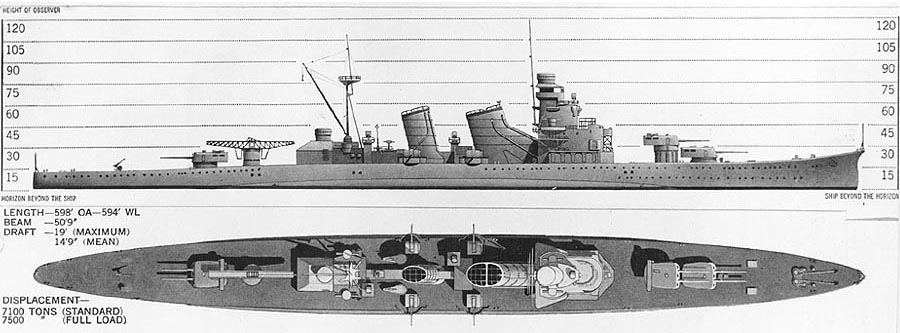
Aoba ONI US Navy archives recognition plate
Modifications brought to the Aoba class were significant compared to the Furutaka pair, with their initial, very odd arrangement of six 20 cm (7.9 in) semi-turrets replaced by three twin turrets, two fore and one aft. The first change was to enable a more rational approach to structural strength for the decks, which were no longer pierced by a series of six large turret wells, creating an obvious weakness. This also enabled a more favourable arc of fire for these turrets, clearing off the decks as well. The main superstructure was also modified to accommodate a new fire control system, which requirements changed to managed twin turrets. The other main change was the adoption of the new 12 cm (4.7 in)/45-cal HA guns to replaced WW1-vintage 7.62 cm (3 in) guns.
Hull and general design
If the hull was generally identical to the Furutaka class, it was still made to achieve the greater speed possible on a light displacement, and limited output. As a result, they ended with a still light displacement of 7,100 tons standard, well below the 10,000 tonnes limit setup at Washington, and 8,900 tons full load. This was still 800t more than expected, though, as the admiralty hoped for a ludicrously light 6500 tonnes. The displacement rose steadily during refits and was already at 9,820t fully loaded after a 360t series of strengthening and upgrades, it ended around 9,088t standard, and 11,660t FL in 1940.
The original plan was standard 8,760t, but ended at 9,773t. This was the result of ignoring some weight discipline and some errors in calculations. The ended heavier, than the previous class, armament leading to further degraded stability. Dimensions were about the same, though at an overall length of 185 m (607 ft), a beam of 16 m (52 ft) and draught of 5.8 m (19 ft).
The general design still included a flush deck with a steps aft, between “X” barbette and the torpedo tubes, and flat sections aft and amidship, plus a gradual slop to the stem, which was almost straight with a beak and characteristic ice breaking chin. There was a modified Tower Bridge compared to the Furutaka, but the same silhouette was kept with a characteristic pair of raked funnels, the first one being truncated.
Powerplant

Aoba on trials in 1927
Propulsion was the same as before with four shaft Parsons geared turbines, fed by 12 Kampon boilers for a total of 102,000 shp (76,000 kW). It should be noted at the time that these Parsons boilers were studied for replication in Japan by Mitsubishi. Kampon already manufactured marine boilers for the IJN, at first derived from Yarrow models. The 12 boilers were split in three groups of four, the first two groups truncated into a single funnel aft of the bridge. There were Mitsubishi-Parsons turbines for Aoba, and Kawasaki Brown-Curtis turbines for Kinugasa until the end.
This machinery made for an initial top speed of 34 knots (63 km/h), with 35 expected, 36 planned. But it was completely unrealistic.
Range was 6,000 nmi (11,000 km) at 14 kn (26 km/h).
Modernization implied that two dual-fuel boilers were converted to heavy oil-only boilers.
Protection
It was light, mostly done to protected against destroyers and light cruiser’s main guns and same as the previous class. One interesting aspect was the absence of protection for the conning tower, a simple shielded tube, and a combination of an upper deck thicker than the waterline main armoured deck which sloped down to the belt.
Belt: 76 mm (3 in)
Magazine: 51 mm (2 in)
Turrets: 25.4 mm (1 in)
Conning tower: none
Decks: 35 mm (1.4 in)
Upper Decks: 48 mm (1.9 in)
Armament
Main Guns:
The 20 cm/50 3rd Year Type naval gun were in three two turret arrangements, 50 calibre and model 1.
The model 1 appeared in 1923 and was replaced by the model 2 in 1932.
Mass 17.6 tonnes, overall 10 metres (33 ft) barrel 9.144 metres (30.00 ft)
Shell: 110 kilograms (240 lb) 20-centimetre (7.874 in), Muzzle velocity 835 m/s (2,740 ft/s)
Maximum firing range 29 kilometres (18 mi).
During the 1932 modernization, “A” turret had its guns changed to the Mark 2. The original 200mm was simply shaved down by 3 mm making it possible to use Type 91 armour-piercing shells.
They used Type C turrets, with maximum elevation of 40. Mark II guns replaced all main guns on the two ships in 1937-1938.
Torpedoes
At the time of completion, these cruisers had the same 12 fixed Type 12 surface launchers installed amidship on deck. It was decided back in 1922 on the Furutakas because the torpedoes at the time were not yet strong enough to withstand firing from the upper deck. The danger of placing torpedoes out on the open was recognized even at the time, and two rotating Type 92 quadruple launchers Type 1, were installed on the upper deck during modernization still, later changed to sixteen Type 93 “long lance” torpedoes (oxygen torpedoes), with a new reloading system installed. Before refit, they ships carried each one spare torpedo for each tube so 24 Type 8 total.
5-in HA
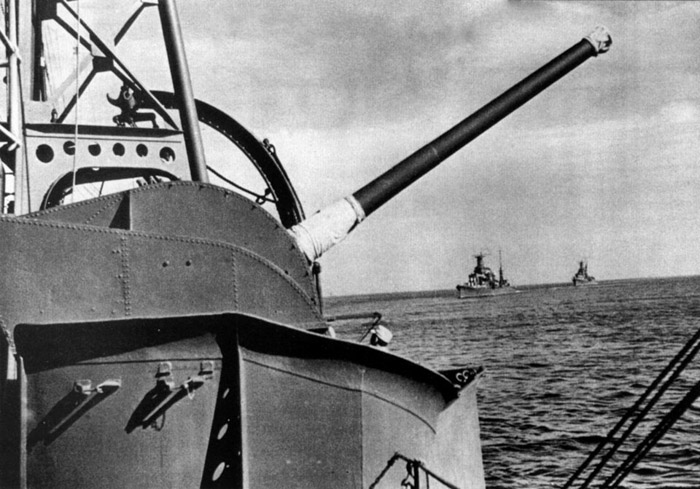
Unlike the Furutaka, the Aoba were fitted for the first time with the potent new dual-purpose artillery called 120mm/45 10-shiki or type 10 (4.7 in). The ubiquitous Type 10 or 12 cm/45 10th Year Type naval gun had the following characteristics:
Mass: 8.5 tons, overall length 5.94 m (19 ft 6 in), barrel 5.4 m (17 ft 9 in) L/45.
Width: 2.16 m (7 ft 1 in), height 2.34 m (7 ft 8 in).
Shell: Fixed QF ammunition 120 x 708R 20.6 kg (45 lb 7 oz). Muzzle velocity: 825 m/s (2,710 ft/s)
Action: Semi-automatic with Horizontal sliding-wedge, Hydro-spring recoil
Elevation -5 to +75 degrees, 10 to 12 rpm
Effective firing range 16,000 m (17,000 yd) surfaced, 8,500 m (27,900 ft) ceiling.
After completion, a weather shield was added some time later, but the guns were not changed during modernization, so both ships kept their four 12cm single-barreled anti-aircraft guns until the end.
Type 93 13.2 mm AA
These machine guns modifications started actually with only two fixed 7.7mm machine guns, but this significantly increased in modernization.
The first step was to install four twin 25mm machine guns around the No. 2 funnel, completed by two twin 13mm machine guns on a platform: forward of the bridge.
Kinugasa in 1942 had this configuration but Aoba, received more, but it’s even not clear in Japanese sources. However, by December 1944 it was estimated they had nine triple 25mm machine guns and six twin 25mm machine guns plus “many” single 25mm machine guns, replacing former 13.2 mm Type 93.
Sensors (Aoba 1944)
Postwar photos showing Aoba equipped with one No. 21 radar and two No. 22 radars on the forward deck. The No. 13 radar was destroyed when the antenna fell off during a torpedo attack in Manila Bay on October 23, 1944. Since the antenna is not visible in postwar photographs, it is possible that it was never repaired.
In November 1943 Aoba allegedly received a Type 1 2-go Radar
In July 1944 Aoba allegedly received a Type 2 2-go radar.
Air Group
Catapult
In 1928 Kinugasa was equipped received a Kure Type 1-1 (pneumatic type) “ejector” (catapult). It was the first practical equipment in the Japanese Navy to launch aircraft from ships. Aoba was equipped with a Kure Type 2-1 (gunpowder type) in April 1930. Kinugasa saw it replaced by a Kure Type 2-1. Both were replaced in turn by a Kure Type 2-5 in the later 1930s.
seaplane Nakajima E2N1 (1927)
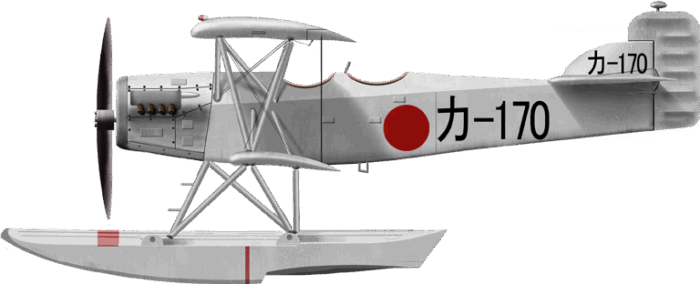
The Nakajima E2N (Type 15) was a naval reconnaissance float plane, single-engine, two-seat, sesquiplane, short range and designed to be suitable for catapult launch from cruisers and battleships. It had two wooden floats, open cockpits, folding wings and was powered by a Mitsubishi “Hi” liquid-cooled engine. The company was inspired by 1918 Hansa-Brandenburg monoplanes tested by Aichi and the Yokosuka Naval Air Technical Arsenal. The E2N1 was the main production variant and the E2N2 a training version produced 1928-1929 with dual controls.
80 were produced between 1927-29 by Nakajima and Kawanishi, two purchased by civil fishery patrol duties. They were retired in 1933-34 to be replaced by the Nakajima E4N, reassigned to training duties or sold to the civilian market. The E2N2 trainer remained in use by the Kasamigaura Kōkūtai until 1936.
Appearance

Cruiser Aoba in 1933, 2 views Author’s illustration

Cruiser Aoba in 1941, after refit – HD 1/200 Author’s illustration
⚙ Aoba class specifications |
|
| Displacement | 7,100 tons standard; 8,900 tons full load |
| Dimensions | 185 x 16 x 5.8m (607 ft x 52 ft x 19 ft) |
| Propulsion | 4-shaft Parsons geared turbines, 12 Kampon boilers: 102,000 shp (76,000 kW) |
| Speed | 34 knots (63 km/h) |
| Range | 6,000 nmi (11,000 km) at 14 kn (26 km/h) |
| Armament 1924 | 2×3 20 cm/50 Mark I, 4× 12 cm/45 HA, 6×2 61 cm TTs |
| Armament 1940 | 2×3 8 in/50 Mark II, 4× 12 cm/45 HA, 8× 25 mm, 8× 61 cm Type 93 TTs |
| Protection | Belt 76 mm, Magazines 51 mm, Turrets 25.4 mm, Decks 35 mm+ 48 mm |
| Sensors | Aoba 1944, see notes |
| Air Group | catapult, 1-2 see notes |
| Crew | 625 |
Later modifications
Modernizations and modifications
In 1930, the Naval General Staff was worried by the limitations imposed by the London Naval Treaty and wanted an extensive modernization program for all four “A class” cruisers. To offset numerical superiority they were to be fitted with the latest weapons, protection, fire control systems and communication systems. By the spring of 1930, the manually operated 12 cm AA were replaced by improved electro-hydraulically operated units. Kinugasa also received later a gunpowder-propelled catapult.
Further modernization was done at the Sasebo Naval Arsenal from October 1937 and only completed in October 1940. It was still smaller in scale than for the Furutaka-class.
The 20 cm (7.9 in)/50-cal Mark I main battery were replaced by Mark II guns with unchanged turrets and gun mounts but powder and shell hoists modified for larger shells and to prevent flash fires from travelling to the magazines.
Light anti-aircraft defences were improved by the addition of four twin sets of 25 mm machine guns and two twin 13.2 mm (0.52 in) machine guns. The 6 pairs of fixed torpedo tube were replaced with 2 quadruple mounts with the new Long Lance, Type 93 torpedo on the upper deck, each side of the catapult.
The bridge structure was rebuilt like for the Furutaka to mount the latest rangefinders and fire control systems for main battery, AA and torpedoes.
Of the twelve original boilers, two smaller ones were mixed-fuel, replaced with oil-fired units and coal bunkers by fuel-oil tanks.
This added 576 tons so to prevent the draft from increasing even more and improve stability, bulges were added, also enhancing anti-torpedo protection with a beam increased by 1.56 m (5 ft 1 in), up to 17.56 m (57.6 ft). Speed fell to 32-33 kts, and displacement rose as well.
Catapults
The Furutaka class also had an old style aeroplane takeoff platform partly mounted atop the N°4 semi-turret. On the Aoba a brand-new catapult, 1st generation, was now fitted fore of the No.3 twin turret, benefiting from a large available clearing. The superstructure aft of the funnels was also heavily modified due to take in account this catapult. However, work on these was not complete by the time these ships were commissioned and Kinugasa used an earlier compressed-air catapult, fitted in March 1928, and Aoba tested the new March 1929 gunpowder-propelled model. The hull was otherwise the same as before as well as the armour scheme and machinery, as well as performances.
Still the usual illness of IJN construction at the time traduced by a 900 tons heavier displacement than the initial design weight. This affected performance just like they plagued the Furutaka class, in addition to a generally grave stability issue typical of the time. This required modifications further down the line.
General Evaluation
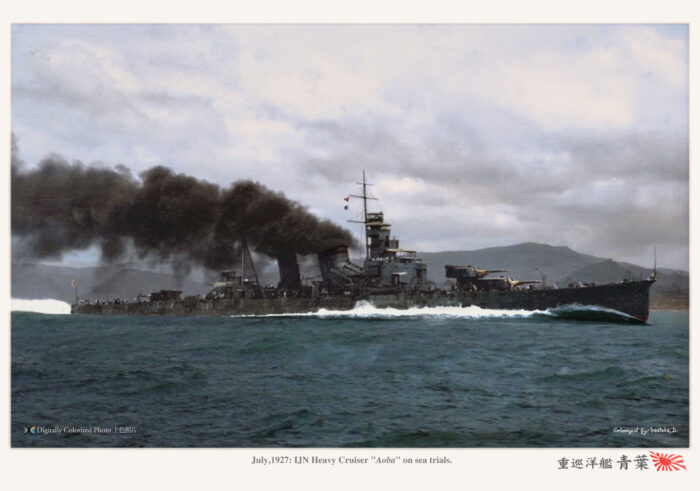
Aoba (青葉) was first of her namesake class to be completed (Named after Mount Aoba, a volcano located behind Maizuru, Kyoto) after being Launched in 1926, and heavily modernized in 1938-40. IJN Aoba patrolled along the China coast and from December 1941, she became flagship of Rear Admiral Aritomo Goto, CruDiv 6. She participated in the Battle of Coral Sea in May 1942, the Battle of Savo Island, 7 August 1942 (damaged) against USS Astoria, Quincy, Vincennes and HMAS Canberra, the Battle of Cape Esperance on 11 October 1942 against USS San Francisco, Boise, Salt Lake City, and Helena (she was hit by up to forty 6-inch and 8-inch shells), was repaired spent time in Kure, statione din Singapore from 24 December 1943, soldiered in the Philippines, heavily damaged, repaired again and finally crippled by bombing, sinking in the shallow waters of Kure harbour in April 1945, followed by more damage after two raids in late July and finished off on 24 July 1945. She was formally stricken on 20 November 1945, her wreck scrapped in 1946–47.
The second ship was launched and completed of the class, IJN Kinugasa, named after a mount. She was flagship of the 5th CruDiv, then 6th and 7th. During a training exercise on 11 July 1929, she collided with I-55 while using the cruiser as a target practice. She also served off the China coast (1928–1929), making other patrols there in the 1930s, place din reserve by September 1937, extensively modernized at Sasebo and recommissioned in October 1940.
Her combat records included: CruDiv6 flagship, Rear Admiral Aritomo Goto, First Fleet (Vice Admiral Takasu Shiro) with Aoba, Furutaka and Kako. Invasion of Guam, second invasion of Wake Island, Truk (Caroline Islands) in Jan-May 1942 protecting convoys and landings in the Solomon Islands, New Guinea, Rabaul, Kavieng, Buka, Shortland, Kieta, Manus Island, Admiralty Islands and Tulagi. At the Battle of Coral Sea she was undamaged, and back in Truk in July, reassigned to the 8th fleet. She fought at the Battle of Cape Esperance on 11 October 1942, damaging Boise and Salt Lake City but taking four hits and was back to the Shortland. She met her fate at the Naval Battle of Guadalcanal: On 14 October 1942, as flagship Crudiv 6 she teamed with Chōkai to bombard Henderson Field and covered on 24–26 October and 1–5 November replacement convoys of troops.
On 14 November, she was attacked by USMC land-based Grumman TBF Avenger torpedo bombers and Douglas SBD Dauntlesses from USS Enterprise. The attack started at 9:30 and at 11:22, she capsized and sank off Rendova Island, stricken on 15 December 1942.
 IJN Aoba
IJN Aoba

Named after Mount Aoba, the lead ship of the new class was voted in 1923FY and ordered, laid down at Mitsubishi NyD, Kawasaki on 23 January 1924, launched on 25 September 1926 and commissioned on 20 September 1927. She was assigned to CruDiv5 until 1933, then CruDiv6 and CruDiv7 as flagship and notably sent to patrol the China coast until 1937, when taken in hands for an extensive modernization and reconstruction at Sasebo NyD, mostly between 1938 and 1940, recommissioned after post refit trials on October 1940, and reassigned to CruDiv6.
In 1941, she became flagship for Rear Admiral Aritomo Goto, 1st Fleet for Vice Admiral Takasu Shiro. CruDiv 6 regrouped all four “A” class cruisers, Aoba, Kinugasa, Furutaka, and Kako, all put to the same modern standards. When the attack on Pearl Harbour took place, CruDiv6 had been prepared for invasion of Guam, and after this, the division took part in the second invasion of Wake Island, which succeeded (repelled once).
Next, they took part in the Battle of Coral Sea. The unit departed Shortland to rendezvous at sea with IJN Shōhō. At 11:00 on 7 May 1942, north of Taguli Island, Shōhō was attacked and sunk by waves of Douglas SBD Dauntless dive bombers combined with TBD Devastator torpedo attacks from USS Yorktown and Lexington.
On 8 May 1942, another wave of 46 SBDs, 21 TBDs and 15 Grumman F4F Wildcats from Yorktown and Lexington damaged IJN Shōkaku severely, escorted by Furutaka and Kinugasa back to Truk while Kako and Aoba covered the withdrawing of the Port Moresby invasion convoy.

Aoba off Buin, Bougainville, October, 13 1942 Battle of Cape Esperance
She refuelled at Shortland on 9 May, and returned to Kure Naval Arsenal on 22 May 1942 for maintenance, back to Truk on 23 June 1942, then moved to Rekata Bay, Santa Isabel Island for patrols until July. On 14 July 1942 she was reassigned to the 8th Fleet, Vice Admiral Mikawa Gunichi, for patrols around the Solomon Islands as well as New Britain, and New Ireland.
On 7 August 1942, she launched her Aichi E13A1 “Jake” to report on US moves, which spotted “a battleship, one auxiliary carrier, four cruisers, seven destroyers, and fifteen transports” off Lunga Point, Tulagi, which led to the Battle of Savo Island on August 9 led by CruDiv 6, with IJN Chōkai, the light cruisers Tenryū and Yūbari, destroyer Yūnagi. This famous night gun and torpedo action started at 23:00, seeing Chōkai, Furutaka, and Kako launching reconnaissance floatplanes to drop flares illuminating targets, destroying USS Astoria, Quincy, Vincennes and HMAS Canberra, damaging USS Chicago, DDs Ralph Talbot and Patterson. Chōkai was hit, Kinugasa but Aoba only received a single hit and Furutaka was unscaved. CruDiv6 sailed to Kavieng but Kako was ambushed and sunk by USS S-44. In August-September, CruDiv6 covered several “Tokyo Express” runs to Guadalcanal.
She took part in the Battle of Cape Esperance on 11 October 1942 with Furutaka, and Kinugasa, DDs Fubuki and Hatsuyuki) departed Shortland to provide cover for a troop reinforcement convoy, shelling Henderson Field (Guadalcanal) but they were spotted by two OS2U Kingfisher down the “Slot” at 30 knots.
Radar-equipped USS San Francisco, Boise, Salt Lake City, Helena plus five destroyers rounded Guadalcanal to block the pass to Savo Sound.
At 22:35, Helena’s radar picked them and the fleet crossed the Japanese “T”, both opening fire. Admiral Goto ordered a 180-degree turn exposing his ships to broadsides and Furutaka with her weak protection was instantly sunk. Aoba was hit near 40 6-inch (152 mm) and 8-inch (203 mm) shells, bridge wrecked, “B” turret knocked out, “X” turret destroyed, four boilers off-line and steam pipes broken, fired everywhere. Admiral Goto was mortally as well as 80 other crewmen killed, many more wounded or gravely burned, dying later. She managed to escape in the night and too refuge to put on fires and made emergency repairs at Shortland, and limped back to Truk on 15 October. Admiral Isoroku Yamamoto personally inspected her and ordered the cruiser to Kure.
She arrived on 22 October and in repairs, “X “turret was covered over a new improvised steel structure with a Type 96 triple 25-mm AA gun installed there, sent back to Truk on 24 February 1943.
On 3 April, she was at anchor at Kavieng when caught by a raid of Boeing B-17 Flying Fortresses (5th AF, 43rd Bombardment Group). She took several near-misses and a direct hit causing her Type 93 Long Lance torpedoes to explode. She burned heavily, obscuring the view of more B-17s, which swapped to lower altitude after dropping all their bombs and were causing havoc by strafing any ships on sight. Aoba’s decks were wrecked by 0.5 cal. Machine gun fire, and she had to be beached to avoid sinking.
Towed back to Truk, she was patched to be sent back to Kure on 1 August, repaired and re-fitted. Her X turret was restored, a Type 21 air-search radar installed and extra AA. Engine damage reduced however, her top speed to 25 knots (46 km/h) until the end.
She was reassigned to the 1st Southern Expeditionary Fleet, relocated to Singapore on 24 December 1943 for escort work. By February 1944, her missions were to Burma, Andaman Islands and Malaya coast. By 25 February, she was reassigned to CruDiv16, and took part in the second Indian Ocean raid of March 1944. From April to June she escorted convoys in the Dutch East Indies and New Guinea. She was refitted at Singapore in July, receiving more AA and a Type 22 surface-search radar.
On 11 October, she accidentally collided with IJN Kinu, for light damage. On 23 October 1944 while underway she was torpedoed by USS Bream. She took a single torpedo in No. 2 engine room but survived, limping back into Cavite Navy Yard (Manila) for emergency repairs and on 29 October was caught by TF 38 aviation and bombed, but damaged was light. After repairs, she was sent to accompany a convoy back to Japan, attacked on 6 November off Luzon by USS Guitarro, Bream, Raton and Ray. Kumano was sunk but Aoba escaped and made into Kure on 12 December, examined but declared irreparable, placed a reserve ship, mostly tasked to provided local AA defence with a skeleton crew.
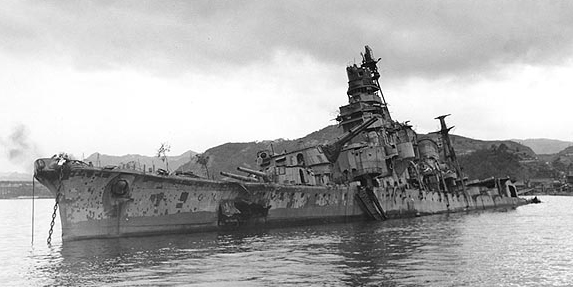
Aoba sunk at Kure, 1945
The US air raid on Kure, on 24 April 1945, saw her demise. Strafed, bombed, taking rockets hits, she sank in the shallow harbour. Her deck still emerged so it was decided to add four additional twin 25-mm AA guns around the mainmast (she had about 50 barrels (5×3, 10×2, 15×1) by then). She was re-rated as a floating AA battery but on 24 July 1945, 30 planes from TF 38 attacked Kure again, and she was bombed, further settling on the bottom after 22:00 hours, under 25 feet (7.6 m). On 28 July 1945, the hulk was attacked and took 4 more direct bomb hits. She burned unattended, four more than a day. The fire attracted 7th AFBG B-24 Liberators, which greeted her by four more direct hits of 500 pounds (230 kg) bombs. This severed her stern.
Stricken on 20 November 1945 she was scrapped in 1946–47.
 IJN Kinugasa
IJN Kinugasa
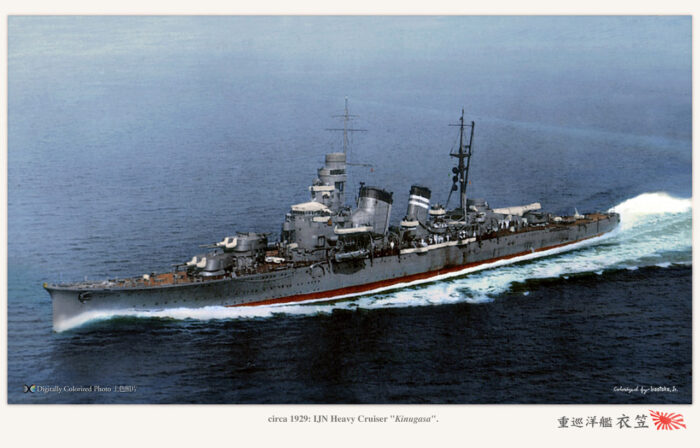
Named after mount Kinugasa, her sister ship was ordered to Kōbe-Kawasaki Shipbuilding Yard and laid down on 24 October 1924, launched on 24 October 1926 and completed on 30 September 1927.
She became flagship of the 5fth Sentai later to the 6th and 7th Squadrons and by 1928, she was the first JJN ship sporting an aircraft catapult. In a training exercise on 11 July 1929 she accidentally collided with I-55 as the latter used Kinugasa as a target. The former was superficially damaged.
Kinugasa took part in the China compaign in 1928–1929 but was placed in reserve in September 1937 for her extensive modernization at Sasebo, recommissioned by October 1940.
As part of CruDiv6 (flagship RZDM Aritomo Goto), 1st Fleet VADM Takasu Shiro she took part in the invasion of Guam and second invasion of Wake Island.
In January–May 1942 based in Truk, she covered landings in the Solomon and New Guinea, Rabaul, Kavieng, Buka, Shortland, Kieta, Manus Island, Admiralty Islands and Tulagi.
She was present at the Battle of the Coral Sea, but cound not prevent Shōhō’s sinking, albeit the following day she escorted Shōkaku back to Truk.
Sent to Japan in June 1942 for maintenance, she was back to Truk by 4 July and from July 1942, ended in the 8th Fleet (Mikawa) in Rabaul.
She took part like her sister to the Battle of Savo Island on 9 August 1942, with Chōkai, Tenryū and Yubari and destroyer Yūnagi in a fierce night gun and torpedo action, launching her floatplane to drop flares. She probably hit Astoria, Quincy, Vincennes and/or Canberra as well as USS Chicago in the engagement. Furthermore, she was also Kinugasa twice, in No. 1 Engine Room (8-in shell from Vincennes, dud) and a 5-in in her storeroom aft, from USS Patterson, causing flooding.
Mikawa decided to fold up leaving the unprotected invasion transports off Guadalcanal. Captain Sawa (Kinugasa) was utterly frustrated by that decision, disobeyed and before departing, approached and launched torpedoes starboard 13 mi (11 nmi; 21 km) from Allied transports but missed.
At the Battle of Cape Esperance on 11 October 1942 she departed Shortland for covering a troop reinforcement convoy, shelling Henderson Field and was spotted down “the Slot” at 30 knots and attacked by radar by one New Orleans class heavy cruiser and three Brooklyn class light cruisers plus five destroyers. The operation started at 22:35 with the “T” crossed, and an error of appreciation by Admiral Goto about a possible friendly fire, ordered a 180-degree turn exposing his flank, a decision seeing Aoba badly damaged, Admiral Goto mortally wounded and Furutaka hit by a torpedo flooding her forward engine room, later sunk by San Francisco and USS Duncan.
Kinugasa straddled Boise and Salt Lake City and managed to destroyer Boise’s A and B turrets. She also took four hits but escaped and the following morning, Kinugasa was attacked by five American planes but missed and made it to Shortland for emergency repairs, departing on 14/15 October 1942 to join Chokai bombarding Henderson Field. In common, they spent 752 8-inch shells. To this, was added the heavy shelling by the Kongo and Haruna the night before and Maya and Myoko even prior.
On 24–26 October and 1–5 November, Kinugasa and Chōkai covered troopships to Guadalcanal. On 14 November she took part in the Naval Battle of Guadalcanal, attacked by Grumman TBF Avenger torpedo bombers and SBD Dauntlesses from USS Enterprise and USMC Avengers from Guadalcanal while back from Henderson Field and at 09:36, she took a 500-pound bomb hit destroying her AA MG mount forward of the bridge, starting a fire in the forward gasoline storage area. Captain Sawa and XO were killed. She started to list to port with near-misses causing more fires and flooding. Next a wave of 17 Dauntlesses bombed her engines and rudder, causing further floosing until at 11:22, she capsized and sank, southwest of Rendova Island with 511 trapped. She was stricken on 15 December 1942.
Sources/Read More
Books
Conway’s all the worlds fighting ships 1921-1946
Jentschura, Hansgeorg; Jung, Dieter & Mickel, Peter (1977). Warships of the Imperial Japanese Navy, 1869–1945. NIP
Lacroix, Eric & Wells II, Linton (1997). Japanese Cruisers of the Pacific War. NIP
Whitley, M. J. (1995). Cruisers of World War Two: An International Encyclopedia. NIP
Magazine “Maru” Editorial Department, “Photos of Japanese Warships, Vol. 6, Heavy Cruisers II” (Kojinsha, 1989)
“Rekishi Gunzo” Editorial Department, “Rekishi Gunzo Pacific War History Series Vol. 44 Heavy Cruisers Furutaka and Aoba Class”
Links
pwencycl.kgbudge.com Aoba_class.htm
web.archive.org navypedia.org/
ja.wikipedia.org/wiki/ aoba
ww2db.com/
Parshall, Jon; Bob Hackett; Sander Kingsepp; Allyn Nevitt. “Imperial Japanese Navy Page – Furutaka class”. CombinedFleet.com.
world-war.co.uk/
Aoba-class_cruiser
combinedfleet.com aoba_t.htm
combinedfleet.com kinugasa_t.htm
blog.livedoor.jp/irootoko_jr/


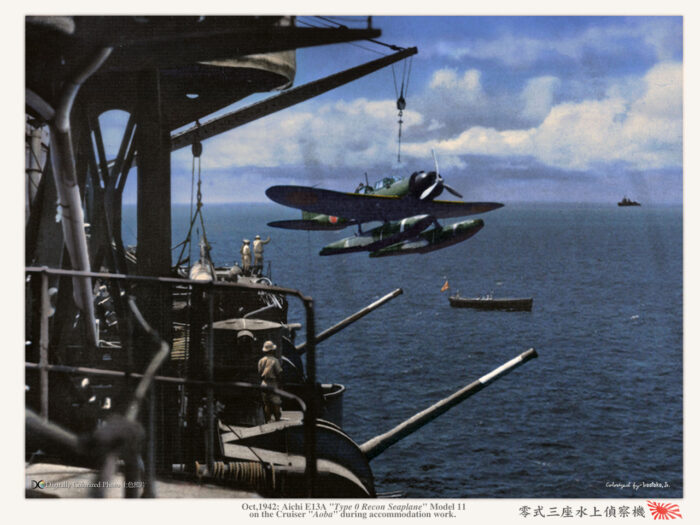
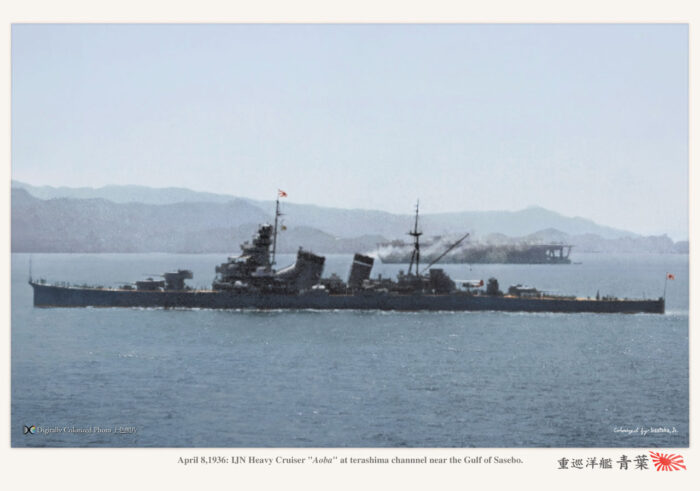
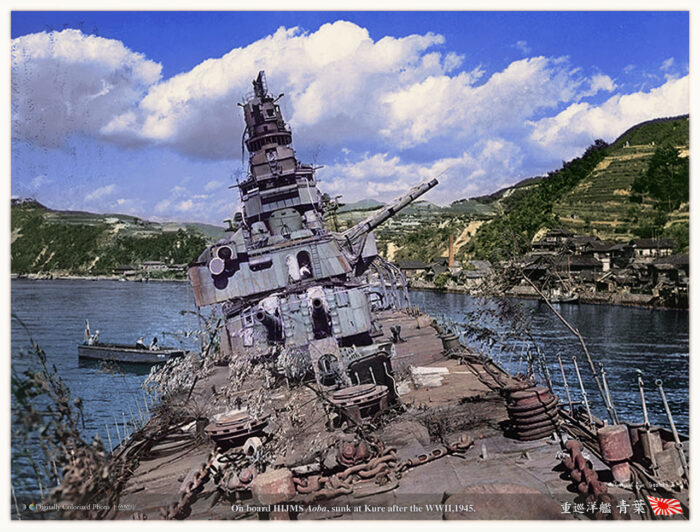
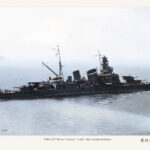
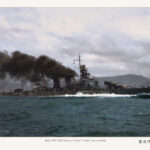
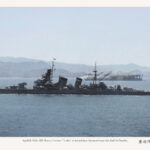
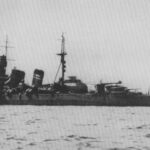
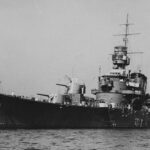
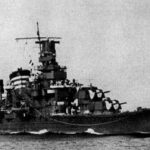
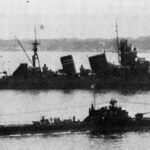
 Latest Facebook Entry -
Latest Facebook Entry -  X(Tweeter) Naval Encyclopedia's deck archive
X(Tweeter) Naval Encyclopedia's deck archive Instagram (@navalencyc)
Instagram (@navalencyc)





 French Navy
French Navy Royal Navy
Royal Navy Russian Navy
Russian Navy Armada Espanola
Armada Espanola Austrian Navy
Austrian Navy K.u.K. Kriegsmarine
K.u.K. Kriegsmarine Dansk Marine
Dansk Marine Nautiko Hellenon
Nautiko Hellenon Koninklije Marine 1870
Koninklije Marine 1870 Marinha do Brasil
Marinha do Brasil Osmanlı Donanması
Osmanlı Donanması Marina Do Peru
Marina Do Peru Marinha do Portugal
Marinha do Portugal Regia Marina 1870
Regia Marina 1870 Nihhon Kaigun 1870
Nihhon Kaigun 1870 Preußische Marine 1870
Preußische Marine 1870 Russkiy Flot 1870
Russkiy Flot 1870 Svenska marinen
Svenska marinen Søværnet
Søværnet Union Navy
Union Navy Confederate Navy
Confederate Navy Armada de Argentina
Armada de Argentina Imperial Chinese Navy
Imperial Chinese Navy Marinha do Portugal
Marinha do Portugal Mexico
Mexico Kaiserliche Marine
Kaiserliche Marine 1898 US Navy
1898 US Navy Sovietskiy Flot
Sovietskiy Flot Royal Canadian Navy
Royal Canadian Navy Royal Australian Navy
Royal Australian Navy RNZN Fleet
RNZN Fleet Chinese Navy 1937
Chinese Navy 1937 Kriegsmarine
Kriegsmarine Chilean Navy
Chilean Navy Danish Navy
Danish Navy Finnish Navy
Finnish Navy Hellenic Navy
Hellenic Navy Polish Navy
Polish Navy Romanian Navy
Romanian Navy Turkish Navy
Turkish Navy Royal Yugoslav Navy
Royal Yugoslav Navy Royal Thai Navy
Royal Thai Navy Minor Navies
Minor Navies Albania
Albania Austria
Austria Belgium
Belgium Columbia
Columbia Costa Rica
Costa Rica Cuba
Cuba Czechoslovakia
Czechoslovakia Dominican Republic
Dominican Republic Haiti
Haiti Hungary
Hungary Honduras
Honduras Estonia
Estonia Iceland
Iceland Eire
Eire Equador
Equador Iran
Iran Iraq
Iraq Latvia
Latvia Liberia
Liberia Lithuania
Lithuania Mandchukuo
Mandchukuo Morocco
Morocco Nicaragua
Nicaragua Persia
Persia San Salvador
San Salvador Sarawak
Sarawak Uruguay
Uruguay Venezuela
Venezuela Zanzibar
Zanzibar Warsaw Pact Navies
Warsaw Pact Navies Bulgaria
Bulgaria Hungary
Hungary

 Bundesmarine
Bundesmarine Dutch Navy
Dutch Navy Hellenic Navy
Hellenic Navy Marina Militare
Marina Militare Yugoslav Navy
Yugoslav Navy Chinese Navy
Chinese Navy Indian Navy
Indian Navy Indonesian Navy
Indonesian Navy JMSDF
JMSDF North Korean Navy
North Korean Navy Pakistani Navy
Pakistani Navy Philippines Navy
Philippines Navy ROKN
ROKN Rep. of Singapore Navy
Rep. of Singapore Navy Taiwanese Navy
Taiwanese Navy IDF Navy
IDF Navy Saudi Navy
Saudi Navy Royal New Zealand Navy
Royal New Zealand Navy Egyptian Navy
Egyptian Navy South African Navy
South African Navy






























 Ukrainian Navy
Ukrainian Navy dbodesign
dbodesign